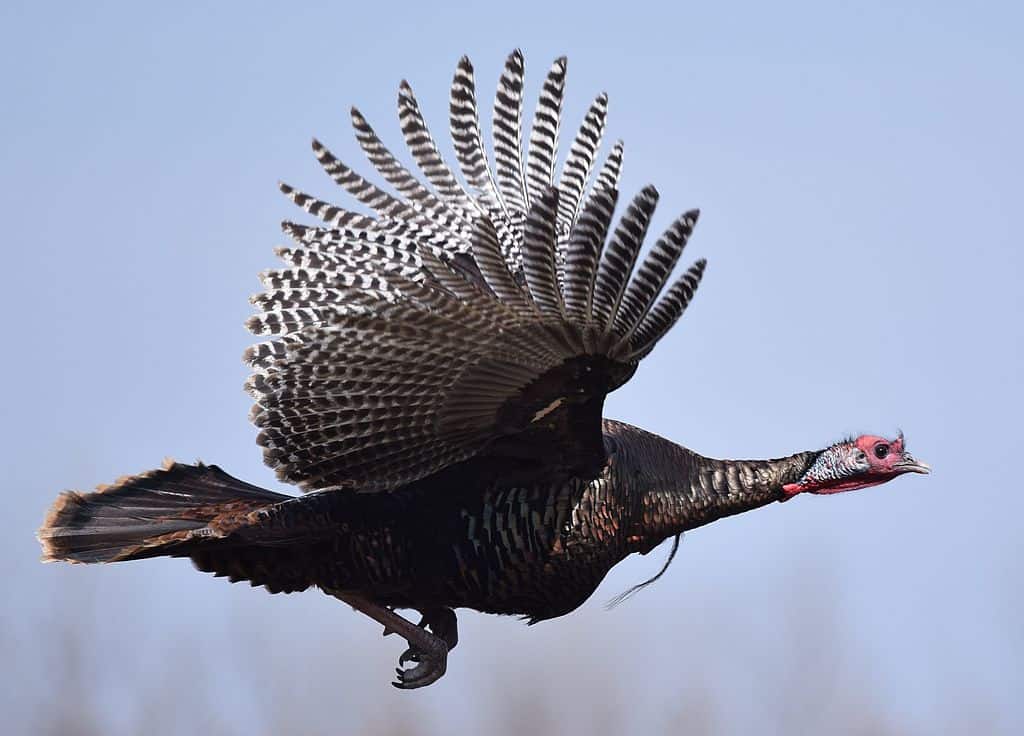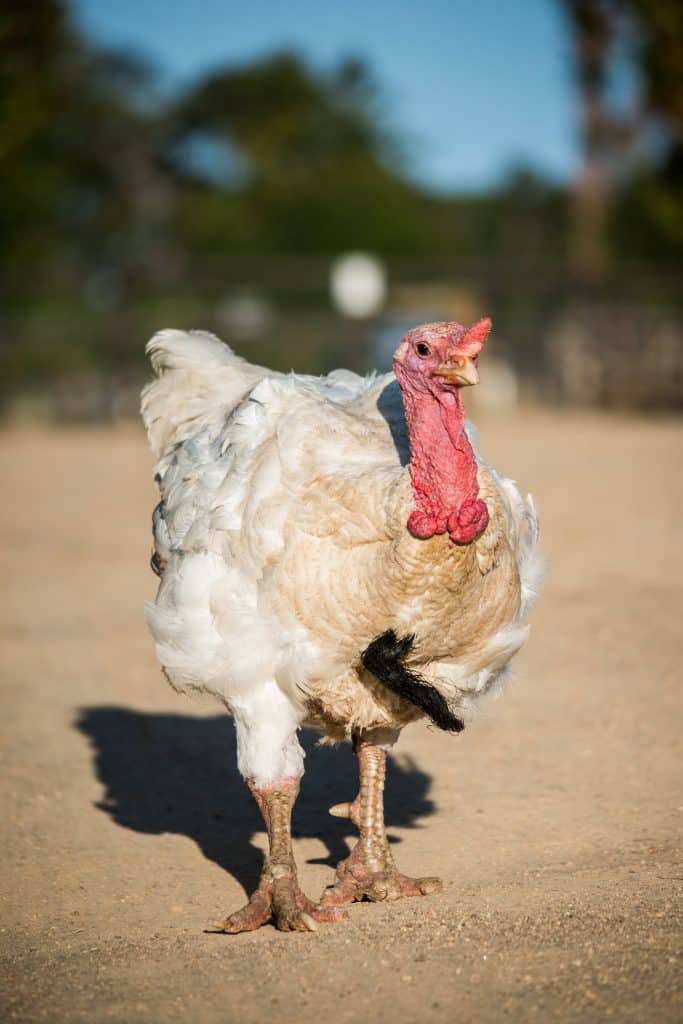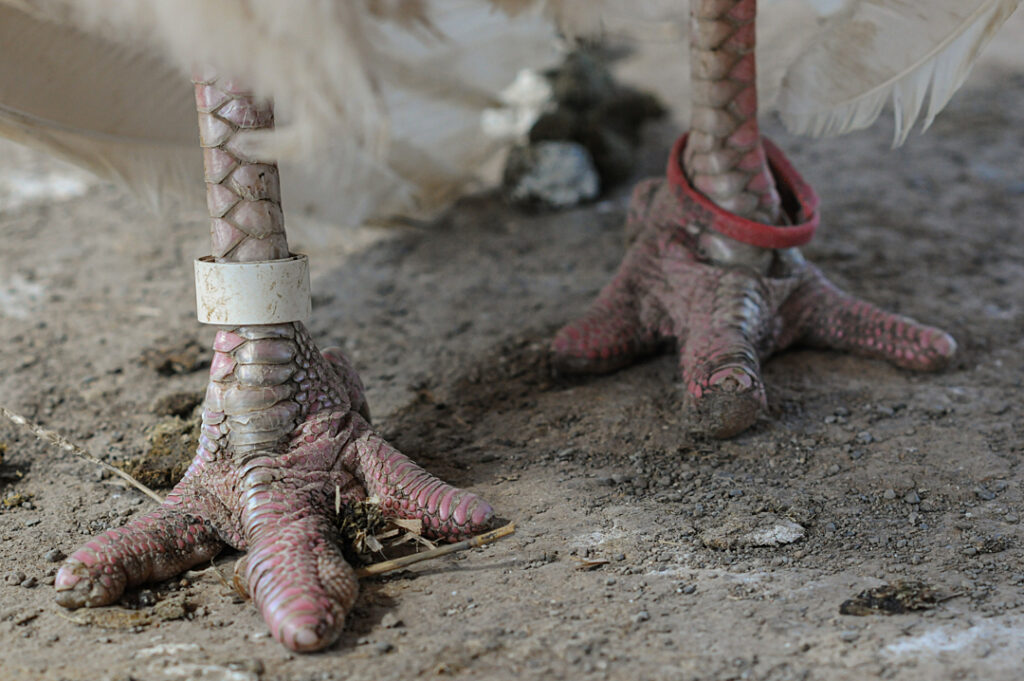
This resource has been fully reviewed and updatedA member of The Open Sanctuary Project’s staff has given this resource a full review and provided updates where necessary. by a member of The Open Sanctuary Project’s team as of June 3, 2025. It was originally published on March 20, 2018.
Did you know that there are only two species of turkeysUnless explicitly mentioned, we are referring to domesticated turkey breeds, not wild turkeys, who may have unique needs not covered by this resource. that exist in the world today: the wild turkeyUnless explicitly mentioned, we are referring to domesticated turkey breeds, not wild turkeys, who may have unique needs not covered by this resource. (Meleagris gallopavo) of North America and the colorful ocellated turkey (Meleagris ocellata) that lives primarily on the Yucatán Peninsula? The domesticatedAdapted over time (as by selective breeding) from a wild or natural state to life in close association with and to the benefit of humans turkey (Meleagris gallopavo domesticus) is actually considered a subspecies of their ancestor, the wild turkey! Wild turkeys can live in a variety of habitats, but typically prefer a mix of woods and open spaces. They are omnivorous foragers who eat mostly plant matter such as nuts, seeds, and berries, but will also eat insects and other small animals. They mostly travel on foot by walking or running, and they nest on the ground. However, they can and do fly short distances, and at night they perch in trees for safety.
Turkeys are highly social. Outside of mating season, wild male turkeys typically live in all-male flocks, and females group together to form larger flocks with their young. In addition to communicating via body language, turkeys also use dozens of distinct calls to communicate with one another.
Domestication
Current scientific evidence suggests that the turkey was domesticated on at least two separate occasions. Over 2,000 years ago, indigenous people of Mesoamerica domesticated the turkey. In a separate domestication event, the turkey was also domesticated by indigenous people of what is now the Southwest United States as early as 900 C.E. Originally, turkeys were raised primarily for their feathers for ceremonies, clothes, blankets, and tools, and they played a significant role in the spiritual traditions of many indigenous American cultures.
In the 1500s, Conquistadors from Spain took domesticated turkeys from Mexico back to Europe. Over the next century, several new breeds* were created, and when British colonists arrived in what is now Massachusetts, they brought with them European lineage domesticated turkeys. Later in the colonization of America, colonists from Europe emblematized the wild turkey as a sign of abundant resources and promise. This romanticization of the turkey and later demand to associate their bodies with celebration has since proven to have drastic consequences for the domesticated turkey and almost led to the extinction of their wild cousins.
*Breeds Vs. Varieties
At The Open Sanctuary Project, we strive to use language carefully to ensure our resources are both resident-centered and accessible. Sometimes this means opting to use terms that are more widely understood, even if the technical definition isn’t a perfect match. Strictly speaking, all domesticated turkeys are the same breed (turkey), and what we refer to as breeds in this and other resources are actually varieties (subsets of a breed). However, you’ll find many other sources that also refer to turkey breeds rather than turkey varieties, and ‘breed’ tends to be a more familiar term. For the purposes of our work, there is no need to get into the weeds of what constitutes a breed and what is a variety, but we do want to acknowledge that there is technically a difference.
In the early 1930’s most domesticated turkeys still had the same dark plumage as their wild cousins and still had a relatively small breast, but a survey of consumers indicated a demand for more white flesh and that consumers did not want any dark pin feathers (they also wanted a carcass that could more conveniently fit in the refrigerator and feed a small family). As a result, the Beltsville Agricultural Research Center started a breeding program to create a domesticated breed that better matched consumer preference (with no regard for the implications this would have on the birds themselves). This led to the creation of the Beltsville Small White, a smaller bird with a larger breast and white feathers. Because consumers desired even more white flesh, the Beltsville Small White was later bred with other breeds to create the Broad Breasted White turkey, the breed most commonly raised in North America.
Turkey Terminology
We use the term ‘large breed’ to refer to farmed animalA species or specific breed of animal that is raised by humans for the use of their bodies or what comes from their bodies. breeds that have been selectively bred by humans to grow as large as possible, as quickly as possible, to the detriment of their health. When it comes to turkeys, we use the term ‘large breed’ to refer to Broad Breasted turkeys (such as the Broad Breasted White and the Broad Breasted Bronze, as well as the many hybrid breeds that exist), and the two terms can be used interchangeably. We use the contrasting term ‘non-large breed’ to refer to heritage breed turkeys.
Turkey Troubles

Though Broad Breasted turkeys (like Marty, shown above) look quite different from their wild cousins, they still share many of the same instincts and preferences. However, because of the way their bodies have been altered, they are no longer able to exhibit some of their natural behaviors. Whereas wild turkeys can fly up to 55 miles per hour, Broad Breasted turkeys (sometimes referred to as ‘industry’ or ‘commercial’ turkeys) have lost the ability to fly due to their abnormal size and body composition. Young turkey poults have shown sanctuary caregivers time and time again that they have not lost the instinct or desire to fly up to a tree branch to roost like their ancestors, and while they are small, they are still able to do so to some degree. However, they become physically unable to do so as they grow, and even perching on a low roost can be difficult because of the way their weight is distributed due to their large breast.
Broad Breasted turkeys have been bred not only to grow significantly larger than wild turkeys, but also more rapidly. Male Broad Breasted turkeys grow three times as large as mature wild turkeys in just four months. This causes intense strain on their bodies and can lead to debilitating injury. In order to prevent obesity and obesity-related issues such as heart problems, bumblefoot, arthritis, and pressure sores, turkey caregivers must provide them with a healthy diet and must carefully manage their portions. They must also be mindful of the living spaces they provide.
It’s not just their size that is unnatural, but also their conformation. Because of their large breast, it is physically impossible for Broad Breasted males to successfully mate with females. Breeding Broad Breasted turkeys relies exclusively on artificial insemination. Even though they are physically incapable of mating, this does not mean Broad Breasted turkeys have lost the instinctual drive to do so. In a sanctuary setting, it is typically necessary to house male and female Broad Breasted turkeys separately because the males can seriously injure females if they mount them. For more information on large breedDomesticated animal breeds that have been selectively bred by humans to grow as large as possible, as quickly as possible, to the detriment of their health. turkey care, read our resource here.
Most domesticated turkeys are raised in large-scale industrial settings. According to Farm Sanctuary, “Nearly 98% of the 223 million turkeys sold in the US are grown on farmsFor-profit organizations focused on the production and sale of plant and/or animal products. that sell more than 30,000 birds a year.” Though the horrors of animal agricultureThe human production and use of animals in order to produce animal products, typically for profit. are not reserved for large-scale operations, turkeys raised in these settings face additional cruelties, including severe overcrowding. Thousands of turkeys are often crammed together in warehouses, and to prevent injuries from the birds pecking and scratching each other, turkey poults are often subjected to painful mutilations during their first few days of life. Debeaking, which the industry disingenuously calls ‘beak trimming,’ is a common practice in which the sensitive tip of the beak is cut or seared off without any anesthetics or analgesics. For those lucky individuals who make it to sanctuary, the loss of a portion of their beak can make eating difficult (and sometimes painful), even long after the mutilation has taken place. These individuals may require special diets of soaked pellets served out of wide, shallow dishes to make it easier for them to scoop food with their lower beak. Some birds may have sensitive beaks for the rest of their life and will do best with food dishes made of rubber rather than hard metal or ceramic.
Another common industry practice is de-toeing (also called ‘toe trimming’ or ‘toe clipping’) in which the ends of a poult’s toes (not just the nail) are cut or seared off. As with debeaking, this is done without anesthetics or analgesics. Without their full toes, individuals who have been de-toed are forced to bear weight unnaturally, adding additional strain to their already compromised feet and joints. Broad Breasted turkeys are already predisposed to bumblefoot and arthritis due to their size, and those who have been de-toed are at an increased risk of developing these issues and may develop them earlier than those who have not been de-toed.

While Broad Breasted turkeys make up the vast majority of turkeys raised in the U.S., heritage breeds are also raised for their flesh. To be considered a heritage breed, they must be able to reproduce naturally and have a slower growth rate. As a result, heritage breed turkeys have a smaller breast than Broad Breasted turkeys, though they are still larger than their wild cousins. Because their body more closely resembles their ancestors, heritage breed turkeys typically have significantly fewer health challenges than large breed turkeys. In addition to being able to mate naturally, heritage breed turkeys are also still capable of flying to some degree, and this must be considered when creating suitable living spaces. While they are capable of roosting in trees, this is not a reliable way to stay safe from predators. They should instead be closed into predator-proof spaces overnight for their protection. Because they have not been bred to grow so unnaturally large, heritage breed turkeys can often be fed free-choice and live significantly longer lives than large breed turkeys. Common breeds include the Bronze (not to be confused with the Broad Breasted Bronze), the Bourbon Red, the Jersey Buff, the Narragansett, the Royal Palm, and the White Holland. The Beltsville Small White mentioned earlier is also considered a heritage breed.
Though non-large breedA domesticated animal breed that has not been specifically engineered to grow as quickly as possible for the purpose of human consumption. In resources at The Open Sanctuary Project, "Heritage" breeds of turkeys, for instance, are "non-large breed", even if they are physically quite big. turkeys may face fewer health challenges than large breed turkeys, all domesticated turkeys raised for their flesh face the same cruel death. The USDA’s Humane Methods of Slaughter Act exempts birds used for their flesh from consideration, so it is not required that they be stunned before slaughter.
The important impacts of turkey ancestry and domestication are both essential to consider when it comes to providing sanctuary for turkey residents. Their similarities to their wild turkey ancestors require that we keep their natural instincts and preferences in mind when it comes to providing them with appropriate living spaces, social groupings, and enrichment. However, it’s also important to understand the ways in which they are different from wild turkeys when considering how we can mitigate the significant impacts that domestication has had on their general health and well-being, as well as our responsibility to ensure their wellness and safety as caregivers. When it comes to providing sanctuary for turkeys, striking an appropriate balance is critical, and understanding both their origins and how they diverge from their ancestors is an important step in achieving this.
SOURCES:
The Complicated History Of The Domesticated Turkey | Discover Magazine
Where Did The Domestic Turkey Come From? | Cornell
The Enigmatic Intelligence Of Turkeys | The Dodo
The Taming Of The Turkey | Science
Turkeys | Food Empowerment Project
Native Americans Domesticated Turkeys Long Before The Pilgrims Arrived | Audubon
Ancient Turkey Bones In Mexico Reveal A Strange Relationship With Humans | NPR
Heritage Turkey Breeds | Heritage Foods USA (Non-Compassionate Source)
A Brief History Of The Turkey | Ohio History Connection (Non-Compassionate Source)
A Brief History Of Turkey Research And The Role Of The Beltsville Agricultural Research Center | USDAThe United States Department of Agriculture, a government department that oversees agriculture and farmed animals. (Non-Compassionate Source)
Probing Question: What Is A Heritage Turkey? | Penn State (Non-Compassionate Source)
Selecting Turkeys | University Of Kentucky (Non-Compassionate Source)
Non-Compassionate Source?
If a source includes the (Non-Compassionate Source) tag, it means that we do not endorse that particular source’s views about animals, even if some of their insights are valuable from a care perspective. See a more detailed explanation here.






